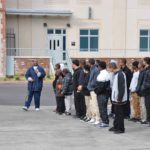“When I came here and saw the elderly population, I said, ‘God, well, why are they here? Our name is Corrections to correct deviant behavior (but) … [Read more...]
Archives for April 2013
Journalist Suggests Changes To Solitary Confinement
California needs to significantly change its policies and practices on solitary confinement, a noted broadcaster said before a group of San Quentin … [Read more...]
Data Reveals 3-Strike Offenders Need Substance Abuse Programs
The trials and tribulations offenders sentenced under California’s Three Strikes law go through are more challenging than any other category of … [Read more...]
New Report Shows How Children End Up in Prison
Children who are suspended, expelled, or arrested are more likely to repeat a grade, eventually dropout of school, enter the juvenile justice system … [Read more...]
Unmarked Graves Still Sit on Boot Hill
Hundreds of poor San Quentin convicts have for decades been lying in unmarked graves in a ridge overlooking the prison, but that situation might … [Read more...]
San Francisco District Attorney Calls for Sentencing Reform
Across the U.S., prosecutors can chart a new path on public safety by championing at both local and state levels one of the biggest ways we can … [Read more...]
The Impact SQUIRES Has on At-Risk Kids
“This works,” a Los Angeles police officer said as he escorted 23 at-risk kids through San Quentin Prison. In his two previous trips to San Quentin, … [Read more...]
Compassionate Release Easier In Fed. Prisons
The Federal Bureau of Prisons has made it easier for offenders who suffer from terminal illnesses or deteriorating health to gain a compassionate … [Read more...]
Long-Time San Quentin Volunteer Dies of Stroke
A long-time San Quentin Prison volunteer, Hari “Ed” Lubin, passed away after a stroke. Born in 1932, he died March 15 at Marin General Hospital, … [Read more...]
What to Tell Young Offenders ?
Recently I sat down with Pendarvis Harshaw, a 24 year-old Oakland freelance writer who met with the San Quentin News staff. In a one-on-one … [Read more...]
- 1
- 2
- 3
- 4
- Next Page »





